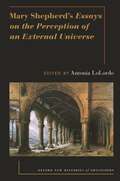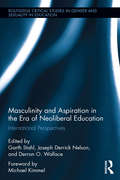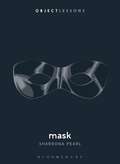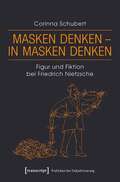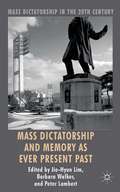- Table View
- List View
Mary Moody Emerson And The Origins Of Transcendentalism: A Family History
by Phyllis ColeMary Moody Emerson has long been a New England legend, the "eccentric Calvinist aunt" of Ralph Waldo Emerson, wearing a death-shroud as her daily garment. This exciting new study, based on the first reading of all her known letters and diaries, reveals a complex human voice and powerful forerunner of American Transcendentalism. From the years of her famous nephew's infancy, in both private and published writings, she celebrated independence, solitude in nature, and inward communion with God. Mary Moody Emerson inherited both resources and constraints from her family, a lineage of Massachusetts ministers who had earlier practiced spiritual awakening and political resistance against England. Cole discovers a previously unexamined Emerson tradition of fervent piety in the ancestors' own writing and Mary's preservation of their memory. She also examines the position of a woman in this patriarchal family. Barred from the pulpit and university by her sex, she also refused marriage to become a reader, writer, and religious seeker. Cole's biography explores this reading and writing as both a woman's vocation and a gift to Ralph Waldo Emerson. Helping to raise her nephews after their father's death, Mary Moody Emerson urged Waldo the college student to seek solitude in nature and become a divine poet. Cole's pioneering study, tracing crucial lines of influence from Mary Emerson's heretofore unknown texts to her nephew's major works, establishes a fresh and vital source for a central American literary tradition.
Mary Shepherd: A Guide (OXFORD GUIDES TO PHILOSOPHY SERIES)
by Deborah BoyleScottish philosopher Lady Mary Shepherd (1777-1847) wrote two books that she conceived as one unified project: Essay Upon the Relation of Cause and Effect (1824) and Essays on the Perception of an External Universe (1827). While they were well received in her day, Shepherd's insightful philosophical writings have been neglected for some 150 years and are only now receiving the scholarly attention they deserve. Mary Shepherd: A Guide by Deborah Boyle, part of the Oxford Guides to Philosophy series, navigates students of philosophy or general readers through Shepherd's two significant works. The first four chapters address topics raised in the 1824 Essay: Shepherd's arguments for two key causal principles, her objections to Hume and her alternative accounts of causation and causal inference; her theory of objects as bundles of qualities; her critique of Thomas Brown's defence of Humean causation; and her discussion of London surgeon William Lawrence's accounts of sentience and life, which Shepherd treats as a case study of how Humean theory can lead to errors in scientific reasoning. Chapter 5 covers topics central to both of Shepherd's books: what she means by "sensation," "idea," "will," "imagination," "understanding," "reasoning," and "latent reasoning." The remaining five chapters proceed systematically through Shepherd's 1827 book, where she seeks to prove, against Berkeleian idealism, that we can know that an external world of mind-independent matter exists. Boyle discusses Shepherd's proofs for such an external world, her responses to various sceptical challenges, and her specific objections to Berkeley. Each chapter ends with a list of works for further reading and a glossary of terms that explain Shepherd's sometimes idiosyncratic philosophical vocabulary, resulting in an essential guide to a philosopher who exerted considerable influence during her time.
Mary Shepherd: A Guide (OXFORD GUIDES TO PHILOSOPHY SERIES)
by Deborah BoyleScottish philosopher Lady Mary Shepherd (1777-1847) wrote two books that she conceived as one unified project: Essay Upon the Relation of Cause and Effect (1824) and Essays on the Perception of an External Universe (1827). While they were well received in her day, Shepherd's insightful philosophical writings have been neglected for some 150 years and are only now receiving the scholarly attention they deserve. Mary Shepherd: A Guide by Deborah Boyle, part of the Oxford Guides to Philosophy series, navigates students of philosophy or general readers through Shepherd's two significant works. The first four chapters address topics raised in the 1824 Essay: Shepherd's arguments for two key causal principles, her objections to Hume and her alternative accounts of causation and causal inference; her theory of objects as bundles of qualities; her critique of Thomas Brown's defence of Humean causation; and her discussion of London surgeon William Lawrence's accounts of sentience and life, which Shepherd treats as a case study of how Humean theory can lead to errors in scientific reasoning. Chapter 5 covers topics central to both of Shepherd's books: what she means by "sensation," "idea," "will," "imagination," "understanding," "reasoning," and "latent reasoning." The remaining five chapters proceed systematically through Shepherd's 1827 book, where she seeks to prove, against Berkeleian idealism, that we can know that an external world of mind-independent matter exists. Boyle discusses Shepherd's proofs for such an external world, her responses to various sceptical challenges, and her specific objections to Berkeley. Each chapter ends with a list of works for further reading and a glossary of terms that explain Shepherd's sometimes idiosyncratic philosophical vocabulary, resulting in an essential guide to a philosopher who exerted considerable influence during her time.
Mary Shepherd's Essays on the Perception of an External Universe (Oxford New Histories of Philosophy)
by Antonia LolordoThis is the first modern edition of the works of Lady Mary Shepherd, one of the most important women philosophers of the early modern period. Shepherd has been widely neglected in the history of philosophy, but her work engaged with the dominant philosophers of the time - among them Hume, Berkeley, and Reid. In particular, her 1827 volume Essays on the Perception of an External Universe outlines a theory of causation, perception, and knowledge which Shepherd presents as an alternative to what she sees as the mistaken views of Berkeley and Hume. What she ultimately presents is an original and systematic metaphysics and epistemology. Shepherd's Essays consists of two parts. The first is a theory of perception and knowledge of the external world, which is designed to rebut idealism and skepticism about the external world and show that our ordinary beliefs are based on reason. The second is a collection of essays on topics in metaphysics and epistemology, including the immateriality and eternity of the mind, the relationship between mind and body, the possibility of miracles, the association of ideas, the relationship between physical and mathematical reasoning, and the epistemology of testimony. Antonia LoLordo's edition of Shepherd's Essays includes scholarly notes throughout the text that provide historical and philosophical context and expand on the major concepts of Shepherd's system. Her extensive introduction to Shepherd's life and works surveys some of the major points of Shepherd's system, points out directions for future research, and offers guidance for readers planning to teach her work in their courses. This volume is an invaluable primary resource for scholars, graduate students, and undergraduates interested in metaphysics, epistemology, and early modern philosophy.
Mary Shepherd's Essays on the Perception of an External Universe (Oxford New Histories of Philosophy)
This is the first modern edition of the works of Lady Mary Shepherd, one of the most important women philosophers of the early modern period. Shepherd has been widely neglected in the history of philosophy, but her work engaged with the dominant philosophers of the time - among them Hume, Berkeley, and Reid. In particular, her 1827 volume Essays on the Perception of an External Universe outlines a theory of causation, perception, and knowledge which Shepherd presents as an alternative to what she sees as the mistaken views of Berkeley and Hume. What she ultimately presents is an original and systematic metaphysics and epistemology. Shepherd's Essays consists of two parts. The first is a theory of perception and knowledge of the external world, which is designed to rebut idealism and skepticism about the external world and show that our ordinary beliefs are based on reason. The second is a collection of essays on topics in metaphysics and epistemology, including the immateriality and eternity of the mind, the relationship between mind and body, the possibility of miracles, the association of ideas, the relationship between physical and mathematical reasoning, and the epistemology of testimony. Antonia LoLordo's edition of Shepherd's Essays includes scholarly notes throughout the text that provide historical and philosophical context and expand on the major concepts of Shepherd's system. Her extensive introduction to Shepherd's life and works surveys some of the major points of Shepherd's system, points out directions for future research, and offers guidance for readers planning to teach her work in their courses. This volume is an invaluable primary resource for scholars, graduate students, and undergraduates interested in metaphysics, epistemology, and early modern philosophy.
Mary Somerville and the Cultivation of Science, 1815–1840 (International Archives of the History of Ideas Archives internationales d'histoire des idées #102)
by E.C. PattersonAmong the myriad of changes that took place in Great Britain in the first half of the nineteenth century, many of particular significance to the historian of science and to the social historian are discernible in that small segment of British society drawn together by a shared interest in natural phenomena and with sufficient leisure or opportunity to investigate and ponder them. This group, which never numbered more than a mere handful in comparison to the whole population, may rightly be characterized as 'scientific'. They and their successors came to occupy an increasingly important place in the intellectual, educational, and developing economic life of the nation. Well before the arrival of mid-century, natural philosophers and inventors were generally hailed as a source of national pride and of national prestige. Scientific society is a feature of nineteenth-century British life, the best being found in London, in the universities, in Edinburgh and Glasgow, and in a few scattered provincial centres.
Mary Somerville and the World of Science: And The World Of Science (SpringerBriefs in History of Science and Technology)
by Allan ChapmanMary Somerville (1780-1872), after whom Somerville College Oxford was named, was the first woman scientist to win an international reputation entirely in her own right, rather than through association with a scientific brother or father.She was active in astronomy, one of the most demanding areas of science of the day, and flourished in the unique British tradition of Grand Amateurs, who paid their own way and were not affiliated with any academic institution.Mary Somerville was to science what Jane Austen was to literature and Frances Trollope to travel writing. Allan Chapman’s vivid account brings to light the story of an exceptional woman, whose achievements in a field dominated by men deserve to be very widely known.
Mary Warnock: Ethics, Education and Public Policy in Post-War Britain
by Philip GrahamThis biography illuminates the life and thought of Baroness Mary Warnock, whose active years spanned the second half of the twentieth century, a period during which opportunities for middle-class women rapidly and vastly improved. Warnock was described as ‘probably the most celebrated philosopher in Britain.’ She began her career as an Oxford University philosophy don and went on to become headmistress of an independent girls’ school. Warnock subsequently chaired two select committees which produced reports of lasting significance, first to children with special needs, and second to childless couples. She then became Mistress of Girton College, Cambridge, and an active member of the House of Lords. Alongside these positions, Warnock wrote twenty books, ranging from the fields of philosophy to education and medical ethics. Her ideas were largely in tune with contemporary progressive thinking but late in life Warnock’s extreme championing of assisted dying for older people won her enemies even among progressives. This authorised biography, written by a friend of the subject, will be of great value to the general reader with an interest in philosophy, ethics, twentieth-century cultural history, and the changing role of women from the 1950s onwards.
Mary Wollstonecraft: Philosophical Mother Of Coeducation (Bloomsbury Library of Educational Thought)
by Susan LairdBest known as author of A Vindication of the Rights of Woman (1792), if not also as mother of Frankenstein's author Mary Shelley, Mary Wollstonecraft survived domestic violence and unusual independent womanhood to write engaging letters, fiction, history, critical reviews, handbooks and treatises. Her work on coeducational thought was a major early modern influence upon the development of a post-Enlightenment tradition, and continues to have vital relevance today.Celebrated as an early modern feminist, abolitionist and socialist philosopher, Wollstonecraft had little formal schooling, but still worked as a governess, school-teacher and educational writer. This succinct critical account of that prolific research begins by recounting her revolutionary self-education. Susan Laird explains how Wollstonecraft came to criticize moral flaws in both men's and women's private education based on irrational assumptions about 'sexual character' under the Divine Right of Kings. It was to remedy those moral flaws of monarchist education that Wollstonecraft theorized her influential, but incomplete, concept of publicly financed, universal, egalitarian coeducation.
Mary Wollstonecraft: Philosophical Mother Of Coeducation (Continuum Library of Educational Thought)
by Susan Laird Richard BaileyBest known as author of A Vindication of the Rights of Woman (1792), if not also as mother of Frankenstein's author Mary Shelley, Mary Wollstonecraft survived domestic violence and unusual independent womanhood to write engaging letters, fiction, history, critical reviews, handbooks and treatises. Her work on coeducational thought was a major early modern influence upon the development of a post-Enlightenment tradition, and continues to have vital relevance today.Celebrated as an early modern feminist, abolitionist and socialist philosopher, Wollstonecraft had little formal schooling, but still worked as a governess, school-teacher and educational writer. This succinct critical account of that prolific research begins by recounting her revolutionary self-education. Susan Laird explains how Wollstonecraft came to criticize moral flaws in both men's and women's private education based on irrational assumptions about 'sexual character' under the Divine Right of Kings. It was to remedy those moral flaws of monarchist education that Wollstonecraft theorized her influential, but incomplete, concept of publicly financed, universal, egalitarian coeducation.
Mary Wollstonecraft and Feminist Republicanism: Independence, Rights and the Experience of Unfreedom (The Enlightenment World)
by Lena HalldeniusMary Wollstonecraft is a writer whose work continues to provoke scholarly debate. Halldenius explores Wollstonecraft’s political philosophy, focusing on her treatment of republicanism and independence, to propose a new way of reading her work – that of a ‘feminist republican’.
Mary Wollstonecraft and Feminist Republicanism: Independence, Rights and the Experience of Unfreedom (The Enlightenment World #30)
by Lena HalldeniusMary Wollstonecraft is a writer whose work continues to provoke scholarly debate. Halldenius explores Wollstonecraft’s political philosophy, focusing on her treatment of republicanism and independence, to propose a new way of reading her work – that of a ‘feminist republican’.
The Maryknoll Sisters in Hong Kong, 1921-1969: In Love With the Chinese
by C. ChuThis book describes the adaptation of American women to cross-cultural situations in Hong Kong from 1921 to 1969. The Maryknoll Sisters were first American Catholic community of women founded for overseas missionary work, and were the first American sisters in Hong Kong. Maryknollers were independent, outgoing, and joyful women who were highly educated, and acted in professional capacities as teachers, social workers and medical personnel. The assertion of this book is that the mission provided Maryknollers what they had long desired - equal emplyment opportunities - which were only later emphasized in the women's liberation movement of the 1960s.
Masculinity and Aspiration in an Era of Neoliberal Education: International Perspectives (Routledge Critical Studies in Gender and Sexuality in Education)
by Garth Stahl Joseph Nelson Derron WallaceThis collection investigates the ways in which boys and young men negotiate neoliberal discourse surrounding aspiration and how neoliberalism shapes their identities. Expanding the field of masculinity studies in education, the contributors offer international comparisons of different subgroups of boys and young men in primary, secondary and university settings. A cross-sectional analysis of race, gender, and class theory is employed to illuminate the role of aspiration in shaping boys’ identities, which adds nuance to their complex "identity work" in neoliberal times.
Masculinity and Aspiration in an Era of Neoliberal Education: International Perspectives (Routledge Critical Studies in Gender and Sexuality in Education)
by Garth Stahl Derron Wallace Joseph NelsonThis collection investigates the ways in which boys and young men negotiate neoliberal discourse surrounding aspiration and how neoliberalism shapes their identities. Expanding the field of masculinity studies in education, the contributors offer international comparisons of different subgroups of boys and young men in primary, secondary and university settings. A cross-sectional analysis of race, gender, and class theory is employed to illuminate the role of aspiration in shaping boys’ identities, which adds nuance to their complex "identity work" in neoliberal times.
Masculinity and Nationhood, 1830-1910: Constructions of Identity and Citizenship in Belgium (Genders and Sexualities in History)
by J. HoegaertsA history of what it meant to be a man, and a citizen of an emerging nation throughout the nineteenth century. This book not only relates how Belgians were taught how to move and fight, but also how they spoke and sang to express masculinity and patriotism.
Masculinity, Class and Music Education: Boys Performing Middle-Class Masculinities through Music (Palgrave Studies in Gender and Education)
by Clare HallThis book offers a provocative sociological examination of masculinity, class and music education within the context of a unique and fascinating culture: the classical musical world of choirboys. The myriad cultural meanings embodied in the ‘boy voice’ are unravelled through compelling musical narratives of young choirboys, their mothers, and their teachers. The book investigates how boys negotiate dominant gender-class discourses and the various pedagogies involved in producing middle-class masculinities during primary school and early years contexts. Drawing on the theoretical resources of Bourdieu to develop the concept of ‘musical habitus’, the continued symbolic distinction of the choirboy is analysed in order to better understand how culture is simultaneously reproduced and evolving through music. This interdisciplinary work at the juncture of pedagogy and culture will appeal to social science researchers, educators and arts practitioners interested in the sociocultural dynamics of music.
Mask (Object Lessons)
by Dr. Sharrona PearlObject Lessons is a series of short, beautifully designed books about the hidden lives of ordinary things.From the theater mask and masquerade to the masked criminal and the rise of facial recognition software, masks have long performed as an instrument for the protection and concealment of identity. Even as they conceal and protect, masks – as faces – are an extension of the self. At the same time, they are a part of material culture: what are masks made of? What traces do they leave behind? Acknowledging that that mask-wearing has become increasingly weaponized and politicized, Sharrona Pearl looks at the politics of the mask, exploring how identity itself is read on this object.By exploring who we do (and do not) seek to protect through different forms of masking, Sharrona Pearl's long history of masks helps us to better understand what it is we value. Object Lessons is published in partnership with an essay series in The Atlantic.
Mask (Object Lessons)
by Dr. Sharrona PearlObject Lessons is a series of short, beautifully designed books about the hidden lives of ordinary things.From the theater mask and masquerade to the masked criminal and the rise of facial recognition software, masks have long performed as an instrument for the protection and concealment of identity. Even as they conceal and protect, masks – as faces – are an extension of the self. At the same time, they are a part of material culture: what are masks made of? What traces do they leave behind? Acknowledging that that mask-wearing has become increasingly weaponized and politicized, Sharrona Pearl looks at the politics of the mask, exploring how identity itself is read on this object.By exploring who we do (and do not) seek to protect through different forms of masking, Sharrona Pearl's long history of masks helps us to better understand what it is we value. Object Lessons is published in partnership with an essay series in The Atlantic.
The Mask and the Flag: Populism, Citizenism and Global Protest (PDF)
by Paolo GerbaudoFrom the Arab Spring to the Spanish Indignados, from Occupy Wall Street in New York to Nuit Debout in Paris, contemporary protest bears the mark of citizenism, a libertarian and participatory brand of populism which appeals to ordinary citizens outraged at the arrogance of political and financial elites in the wake of the Great Recession. This book draws on 140 interviews with activists and participants in occupations and demonstrations to explore the new politics nurtured by the ‘movement of the squares’ of 2011–16 and its reflection of an exceptional phase of crisis and social transformation. Gerbaudo demonstrates how, in waging a unifying struggle against a perceived Oligarchy, today’s movements combine the neo-anarchist ethos of horizontality and leaderlessness inherited from the anti-globalisation movement, and a resurgent populist demand for full popular sovereignty and the reclamation of citizenship rights. He analyses the manifestation of this ideology through the signature tactics of these upheavals, including protest camps in public squares, popular assemblies and social media activism. And he charts its political ramifications from Podemos in Spain to Bernie Sanders in the US, revealing how the central square occupations have been foundational to current movements for radical democracy worldwide.
Masken denken - in Masken denken: Figur und Fiktion bei Friedrich Nietzsche (Praktiken der Subjektivierung #19)
by Corinna SchubertAls kulturgeschichtlich bedeutsame Phänomene entstammen Masken der Ritual- und Theaterpraxis und traten schon in der Antike als Metapher in den Sprachgebrauch über. Kaum ein Philosoph hat den Masken so viel Raum gegeben wie Friedrich Nietzsche: Sie sind ihm Hilfsmittel der Erkenntnis und conditio humana, sie ermöglichen Höflichkeit und Selbstschutz, fungieren aber auch als Darstellungsform. Corinna Schubert führt zentrale Themen seines Denkens unter einem neuen Gesichtspunkt zusammen und erschließt sie als Philosophie der Masken. Dabei geht es nicht nur darum, was Nietzsche über Masken denkt, sondern auch, wie er mit und in Masken denkt.
Masonry Structures: Between Mechanics and Architecture
by Danila Aita Orietta Pedemonte Kim WilliamsThe book aims to provide an overview of the state of the art on the mechanics of arches and masonry structures. It is addressed to an international audience, arising from the international context in which the Associazione Edoardo Benvenuto has carried out its activities in recent years, under the honorary presidency of Jacques Heyman. The book belongs to the collection Between Mechanics and Architecture, born in 1995 from the collaboration of several renowned scholars, including Edoardo Benvenuto (P. Radelet-de Grave, E. Benvenuto (eds.), Entre Mécanique et Architecture / Between Mechanics and Architecture, Birkhäuser, Basel 1995).
The Mass Deportation of Poles to Siberia, 1863-1880
by Andrew A. GentesThis book concerns the mass deportation of Poles and others to Siberia following the failed 1863 Polish Insurrection. The imperial Russian government fell back upon using exile to punish the insurrectionists and to cleanse Russia’s Western Provinces of ethnic Poles. It convoyed some 20,000 inhabitants of the Kingdom of Poland and the Western Provinces across the Urals to locations as far away as Iakutsk, and assigned them to penal labor or forced settlement. Yet the government’s lack of infrastructure and planning doomed this operation from the start, and the exiles found ways to resist their subjugation. Based upon archival documents from Siberia and the former Western Provinces, this book offers an unparalleled exploration of the mass deportation. Combining social history with an analysis of statecraft, it is a unique contribution to scholarship on the history of Poland and the Russian Empire.
The Mass Deportation of Poles to Siberia, 1863-1880
by Andrew A. GentesThis book concerns the mass deportation of Poles and others to Siberia following the failed 1863 Polish Insurrection. The imperial Russian government fell back upon using exile to punish the insurrectionists and to cleanse Russia’s Western Provinces of ethnic Poles. It convoyed some 20,000 inhabitants of the Kingdom of Poland and the Western Provinces across the Urals to locations as far away as Iakutsk, and assigned them to penal labor or forced settlement. Yet the government’s lack of infrastructure and planning doomed this operation from the start, and the exiles found ways to resist their subjugation. Based upon archival documents from Siberia and the former Western Provinces, this book offers an unparalleled exploration of the mass deportation. Combining social history with an analysis of statecraft, it is a unique contribution to scholarship on the history of Poland and the Russian Empire.
Mass Dictatorship and Memory as Ever Present Past (Mass Dictatorship in the Twentieth Century)
by Peter Lambert Jie-Hyun Lim Barbara WalkerThis volume explores the politics of memory involved in 'coming to terms with the past' of mass dictatorship on a global scale. Considering how a growing sense of global connectivity and global human rights politics changed the memory landscape, the essays explore entangled pasts of dictatorships.


